 |
|||||
|
|||||
| Preview of Stamps Catalogue: VOLUME 1 |
 |
|||||
|
|||||
| Preview of Stamps Catalogue: VOLUME 1 |
Colonies Françaises, Emissions générales
Return To Catalogue - French colonies, general 1881 issue - French colonies, overview - French colonies, postage due stamps - French colonies forgeries - France overview
Note: on my website many of the
pictures can not be seen! They are of course present in the catalogue;
contact me if you want to purchase it.
1 c olive 5 c green 10 c brown 20 c blue 40 c orange 80 c red
Value of the stamps |
|||
vc = very common c = common * = not so common ** = uncommon |
*** = very uncommon R = rare RR = very rare RRR = extremely rare |
||
| Value | Unused | Used | Remarks |
| 1 c | *** | *** | |
| 5 c | *** | *** | |
| 10 c | *** | * | |
| 20 c | R | *** | |
| 40 c | *** | *** | |
| 80 c | R | R | |

The surcharges '5 c. R' on 40 c orange and '25 c. R' on 40 c orange were used in Reunion. The 10 c exists printed together with another 10 c which is turned 90 degrees, the so-called couche variety (often incorrectly called tete-beche):

Two 10 c stamps with a 'couche' variety with a 'PD' cancel
Some typical cancels:


An 'Anchor' cancel on a 10 c value
Forgeries and reprints:

(A dot in the leaf)
In the genuine stamps, there must be a dot in the leaf at the upper right hand side as shown in the above image. For information concerning forgeries of these stamps, click here.
Reprints also exist, they have brighter colours than the original stamps. I have no further information.
1 c green 5 c green 30 c brown 80 c red
For stamps in the same type, but perforated, see France Napoleon III issues.
Value of the stamps |
|||
vc = very common c = common * = not so common ** = uncommon |
*** = very uncommon R = rare RR = very rare RRR = extremely rare |
||
| Value | Unused | Used | Remarks |
| 1 c | R | R | |
| 5 c | RRR | RR | This stamp is difficult to distinguish from the
normal imperforate France stamps. Check the cancel and the slightly different color. |
| 30 c | RR | R | |
| 80 c | RRR | RR | |
A surcharge '5 c. R' on 30 c brown was used in Reunion.
1 c green 2 c brown 4 c grey 5 c green 10 c brown 10 c brown on red 15 c brown (2 types) 20 c blue 25 c blue 30 c brown 40 c orange 80 c red
The 4 c only seems to have been used in Cochin-China.
Value of the stamps |
|||
vc = very common c = common * = not so common ** = uncommon |
*** = very uncommon R = rare RR = very rare RRR = extremely rare |
||
| Value | Unused | Used | Remarks |
| 1 c | R | *** | |
| 2 c | RRR | RRR | |
| 4 c | RRR | RRR | This stamp was only used in Indochina according to my 1931 Yvert & Tellier catalogue. |
| 5 c | *** | ** | |
| 10 c brown | RR | R | exists tete-beche |
| 10 c brown on red | RR | *** | |
| 15 c | RRR | RR | Large value inscription |
| 15 c | RR | *** | Small value inscription |
| 20 c | RRR | RR | Exists tete-beche |
| 25 c | R | *** | |
| 30 c | R | R | |
| 40 c | RR | R | Exists with '4' large |
| 80 c | RRR | RR | |
These stamps, but perforated were issued for France. Don't confuse these stamps with the imperforate Bordeaux issue of France. The Bordeaux issue has different facial expression and the top of the head does not reach as far towards the ring with pearls as in above French Colonies stamps. Possibly the easiest way to distinguish them are the 'R' of 'REPUB.' and the 'C' of 'FRANC'; they are quite close to the left and right borders for the French Colonies issue, while they are far away from the borders in the Bordeaux issue.
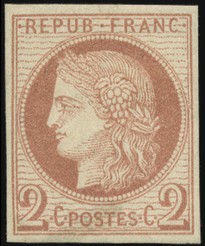
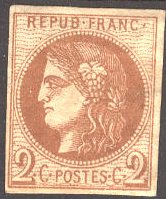
Left: French colonies 2 c stamp, right: a 2 c Bordeaux issue
A surcharge '5 c. R' on 40 c orange was used in Reunion.


(Small and large value '15')
For the specialist: the 15 c brown exist in two types, with small numbers '15' and with large number '15'.

The above stamp has a special cancel from one of the British colonies 'B62': Hongkong.
1 c green 1 c black on blue 2 c green 2 c brown on yellow 4 c green 4 c brown on grey 5 c green 10 c green 10 c black 15 c grey 15 c blue 20 c brown 20 c red on green 25 c blue 25 c black on red 25 c yellow 30 c brown 35 c brown on yellow 40 c red on yellow 75 c red 1 F olive
These stamps exist in similar types as those of France.
Value of the stamps |
|||
vc = very common c = common * = not so common ** = uncommon |
*** = very uncommon R = rare RR = very rare RRR = extremely rare |
||
| Value | Unused | Used | Remarks |
| 1 c green | R | R | Type 1 |
| 1 c black on blue | R | *** | Type 2 |
| 2 c green | R | *** | Type 2 |
| 2 c brown on yellow | R | R | Type 2 |
| 4 c green | R | R | Type 1 |
| 4 c brown on grey | R | R | Type 2 |
| 5 c | R | *** | Type 2 |
| 10 c green | RR | *** | Type 2 |
| 10 c black | RR | R | Type 2 |
| 15 c grey | RR | RR | Type 2 |
| 15 c blue | RR | R | Type 2 |
| 20 c brown | RR | *** | Type 2 |
| 20 c red on green | RR | R | Type 2 |
| 25 c blue | R | *** | Type 2, a rare shade of blue exist of this stamp |
| 25 c black on red | RRR | RRR | Type 2 |
| 25 c yellow | RR | RR | Type 2 |
| 30 c | R | R | Type 1 |
| 35 c | R | R | Type 2 |
| 40 c | *** | *** | Type 1 |
| 75 c | RR | RR | Type 1 |
| 1 F | R | R | Type 1 |
Reprints were made in type 2, also of some non issued values: 3 c yellow, 15 c yellow, 20 c blue, 25 c red and 5 F lilac.
Surcharged stamps , used in several french colonies (without indication of the colony name):
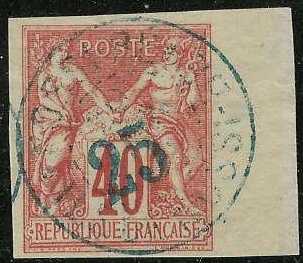
'25' on 40 c
'25 c' on 35 c, '25 c' on 40 c
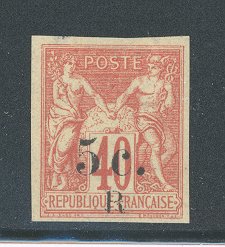
'5 c. R' on 30 c brown '5 c. R' on 40 c red '10 c. R' on 40 c red '20 c. R' on 30 c brown
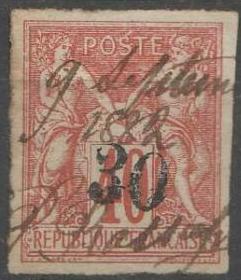
"30" on 40 c stamp, fiscally used stamp from French India in 1882. A "30" on
35 c also exists.
These stamps, but perforated were used in France. Don't confuse these stamps with square cuts from envelopes of France, which are often offered as French colony stamps, examples:



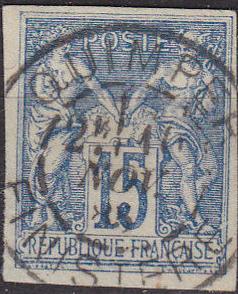
Square cuts from France exist of the following values: 1 c black,
2 c brown, 3 c red (sometimes offered as a rare 'proof'!), 5 c
green, 10 c black, 15 c blue and 25 c black. Note the French
cancels (Gers, Aisne, Var, Finistere....).
Stamp of the French colonies used in Mayotte:
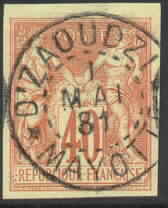
Probably cancelled to order (oblitération de complaisance).
I haven't seen many forgeries of these stamps, but be careful with perforated stamps with their perforation being cut off or cuts from postal stationary of France which are very often offered as French Colonies stamps (check the cancel). Nevertheless there appears to be a set of forgeries. The "S" of "POSTE" is very strange and the "L" of "REPUBLIQUE" is aligned with the left line of the central rectangle. In the genuine stamps, this line is aligned with "LI" of this word. There are many other small differences.
I've seen pairs of these forgeries in the values 15 c, 20 c, 25 c, 30 c, 35 c, 40 c and 75 c with various cancels "HELLE VILLE 1E/17 SEPT 8?", "LIBREVILLE CONGO ?? 1E/15 DEC", "DIEGO SUAREZ 2E/16 JANV 92" and "? PIERRE MIQUELON 1E/6 ?", "NOUVELLE CALEDONIE 2E/26 FEVR".
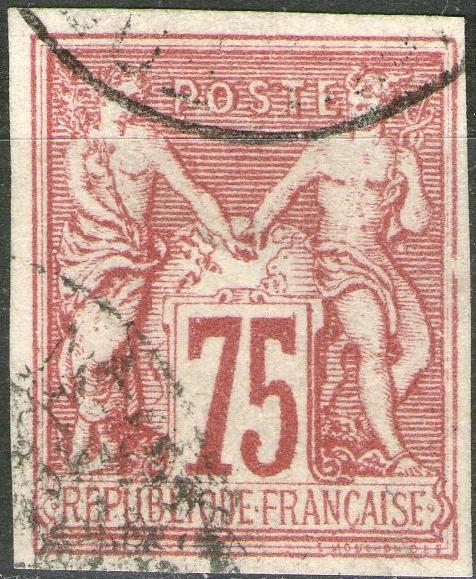
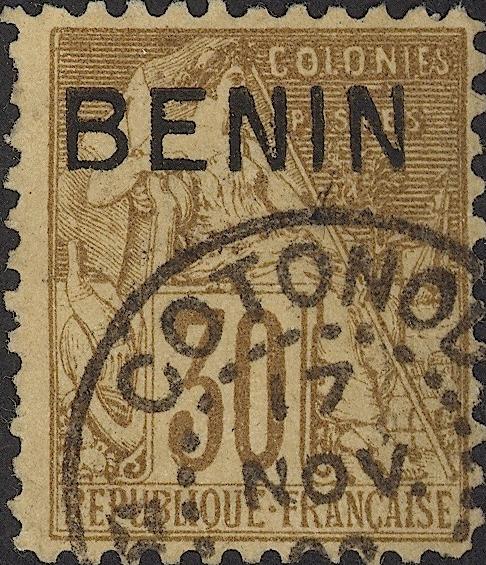
I think this forgery of the next issue was made by the same
forger? It has the same defective "E" in
"FRANCAISE".

Not sure what is this, a mystery item in a similar design, but
with "REPUB FRANC" at the bottom, 25 c red, with a
cancel consisting of tiny dots.


Left: forgery? Right: genuine stamp. Note that the "15"
is smaller in the forgery.
For French colonies, general 1881 issue, click here.
Before 1876 the stamps of the french colonies were cancelled
with 3 or 4 letters (different for each colony) in a diamon like
shape with dots. The following letters exist:
ASI = Asinia (French Guinea), 1863-1878 (blue) CCH = Cochin-China GAB = Gabon, 1862-1876 (blue or red) GOR = Gores (French Guinea), 1863-1879 (blue) GPE = Guadeloupe (Pointe-a-Pitre and Basse-Terre) 1871-1910 (blue) GNE = French Guinea (might not exist?) INDE = French India (Pondichery 1863-1877 and Karikal 1870'2-1890's) MQE = Martinique, 1864-1879 (blue) MYE = Mayotte (might not exist?) NCE = New Caledonia (does not exist?) NSB = Nossi Be, 1864(?)-1876 (blue) OCN = Oceanic Settlements (Papeete), 1864-1876 R or REN = Reunion (might not exist?) SEN = Senegambia and Niger (might not exist?) SNG = Senegal SPM = St. Pierre and Miquelon T1 = Tonkin, 1870's (blue)
Examples:

("CCH" Cochin China cancel, together with an anchor
cancel)
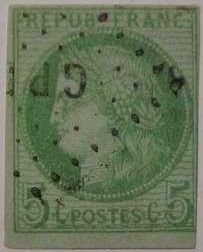

("GPE" Guadelupe and "INDE" French India)



("MQE" Martinique and "SNG" Senegal)
From 1876 on, ordinary cancels were used in the french colonies.


Special cancel: anchor (overseas mail, 'Poste Maritime'), this
cancel can also be found on stamps of France (second image).
Other mute cancels were used in (source "The Lozenge Obliterations of French Colonies by R.G.Stone" 1977):
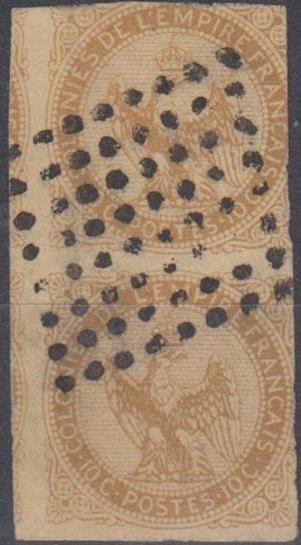
French colonies stamps with a 8x8 dotted diamond cancel.

Noumea (New Caledonia) 8x8 (smaller) dots cancel.

India, 9x9 dots cancel

7x7 dots cancel, not sure if this is from Guadeloupe or Reunion?
Senegal (St.Louis); a 8 by 8 dotted diamond shape in blue color from 1860 to 1864.
Guiana (Cayenne): a 8 by 8 dotted square from 1860 to 1876 (with one or more corner points often missing).
Noumea; a 8 by 8 dotted diamond shape (but much smaller than the Senegal one, only 15 mm), used from 1870 to 1876.
Guadeloupe; a 8 by 8 dotted diamond shape (but more squeezed than the Senegal one),
used from 1869 to 1879 in Pointe-a-Pitre (black?)
and from 1862 to 1877 in Basse Terre (blue color).
India (Yanaon) as the Guadeloupe cancel used in the 1860's but with a 9 by 9 dots.
Mayotte: Similar to the dotted cancels with letters, but with an empty space in the center (used from 1864? to 1880);
applied in blue color.
Reunion: 7 by 7 dotted diamond shaped (usually in blue)
For postage due stamps of the French Colonies, click here.
Stamps - Timbres-Poste - Briefmarken - Postzegels